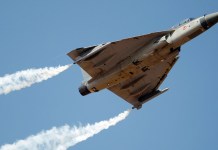Once a stalwart in combat, Apache attack helicopters are now fast losing their sheen, with buyers like South Korea reconsidering their purchase to focus on unmanned aerial systems. India, on the other hand, is still awaiting the delivery of these choppers purchased at an incredibly high cost.
The Indian Army had inked a $600 million deal for six Apache AH-64E helicopters with the US in 2020. The first batch of Apaches was initially scheduled to arrive in India by May-June 2024 — a timeline that has been pushed back repeatedly due to disruptions in the supply chain.
Finally, the first three of the six Apache AH-64Es ordered for the Indian Army are expected to be delivered by mid-July, and the remaining three are scheduled for delivery in November, according to the latest reports in Indian media.
The choppers will be stationed at the first Apache rotary wing aircraft squadron, raised by the Indian Army in March 2024 in Jodhpur.
The new delivery timeline was announced after Indian Defense Minister Rajnath Singh held a phone call with US Defense Secretary Lloyd Austin on July 1.
It is noteworthy that, despite the imminent delivery of the Apache AH-64E, the purchase has come under scrutiny altogether. Some experts and veterans have questioned the feasibility of purchasing new attack helicopters at a prohibitive cost, given that advanced militaries are currently focusing their attention on unmanned systems.
Other experts cite the example of South Korea, a close US ally, that has now put the purchase of additional Apaches under reconsideration.
South Korean Example
A South Korean daily reported last year that the South Korean military was reassessing its decision to acquire an additional 36 AH-64E Apache attack helicopters from the US due to mounting concerns about the vulnerability of helicopters in modern combat, as demonstrated in the ongoing conflict in Ukraine.
The report said that the South Korean Ministry of National Defense, the Republic of Korea Army (ROKA), and the Defense Acquisition Program Administration have started a comprehensive review of the Apache acquisition plan.
“There is already a sentiment within the Army that it may not acquire all 36 units due to these concerns,” a source cited by the report noted. The source even hinted that the entire purchase could be scrapped.

According to reports, South Korea may be prioritizing its indigenous Light Armed Helicopter (LAH) program and shifting its focus toward unmanned systems for improved survivability and cost-effectiveness.
Even countries like Poland, which have purchased the Apache in recent times, have been given financial support by the US. For instance, Washington provided a $3.08 billion loan to Poland in October 2024 under the Foreign Military Financing (FMF) program to support the purchase of Apaches. These loans, reserved for key U.S. allies, are intended to alleviate the financial burden.
Citing the South Korean example, Indian Air Force veteran and popular military commentator, Squadron Leader Vijainder K. Thakur (retd.) said: “The South Korean government has canceled the purchase of 36 additional AH-64E Apache Guardian helicopters, shifting its focus to unmanned systems. The cost of acquiring one Apache helicopter has increased by 160% over the past decade, making the project uneconomical.”
“I believe India’s AH-64E procurement needs a rethink,” he added.
India’s Purchase Of Apache: Feasible Or Not?
This reconsideration of the Apache purchase by South Korea was based on two factors: the less-than-satisfactory combat performance of the Apache in swiftly evolving battlefields, such as Ukraine, and the simultaneous rising cost of these helicopters.
The Ukraine conflict has highlighted the extreme vulnerability of attack helicopters to advanced air defense systems, particularly man-portable air defense systems (MANPADS) and short-range air defense (SHORAD) systems. Typically, these systems are highly mobile, fast-reacting, and capable of engaging low-flying helicopters with precision.
This suggests that advanced helicopters, such as the Boeing Apache, which rely on low-altitude, nap-of-the-earth (NOE) tactics, face high risks in environments saturated with air defenses, despite being heavily armored.
The dynamics of the battlefield have changed due to the extensive use of low-cost, attritable drones, such as first-person-view (FPV) drones and loitering munitions, as seen in the ongoing conflict in Ukraine. These drones have been used to target helicopters both in the air and on the ground, with footage showing Ukrainian drones destroying Russian helos.
Critics contend that drones are increasingly replacing attack helicopters in roles like reconnaissance and precision strikes as they are significantly less expensive and less risky.
“With the rise of highly effective modern short-range air defense systems, the growing deployment of MALE drones armed with ATGMs, and the proliferation of AI-enabled kamikaze drones capable of autonomously tracking and striking moving targets, the battlefield is rapidly evolving. Given this tactical shift, should the Indian Army, MoD, and DRDO reconsider their attack helicopter procurement plans to adapt to the changing nature of warfare?” Thakur asked in a poll on X in March 2025.
China Hails Russia’s Decision To Recognize Taliban Rule In Afghanistan; Will Beijing Follow Suit?

The Apache 64 is a twin-turboshaft, four-blade helicopter that makes target acquisition easier with a suite of sensors installed on the nose. Target location, tracking, and attack are made possible by the helicopter’s laser, infrared, and other systems. There are also 70mm rockets, laser-guided precision Hellfire missiles, and a 30mm automatic cannon that can fire up to 1,200 rounds of high-explosive, dual-purpose ammunition.
The helicopter is designed to operate in mountainous terrain. It can operate in hostile airspace with ground threats and launch precision attacks at standoff ranges.
The Indian Army has been impressed by the helicopter’s ability to remotely control drones, which enables the crew to extend its operational scope and enhance reconnaissance capabilities, allowing it to direct drones for observation, surveillance, and attack missions.
Buyers like the Indian Army might see Apache’s Manned-Unmanned Teaming (MUM-T) as a potential adaptation to counter the threat posed by hostile drones and enhance survivability.
However, the integration of such systems is still evolving and may not fully mitigate the risks posed by drone swarms.
Under its Army Transformation Initiative, the US Army is working to cut down its rotary-wing fleet as part of its restructuring. The restructuring involves eliminating all D-model Boeing AH-64 attack helicopters. Lt. Gen. Joseph Ryan, the US Army’s deputy chief of staff for operations, said the older AH-64D (Apache), which is now into its third decade of service, “is not a war-winning capability that we can fight with and win today.”
Even the most recent upgrades to the AH-64E (the variant that India has purchased) — the most advanced Apache helicopter — “are also on the cusp of being capabilities where we don’t necessarily see them contributing to the fight the way they have done perhaps in the past,” Lt. Gen. Ryan said.
This, coupled with a high cost, makes the Apache less feasible, according to experts, especially since the Apaches are maintenance-intensive, requiring approximately 35 hours of maintenance per flight hour, with an operating cost of approximately $5,494 per hour.
While Apaches are suited for Pakistan’s tank-heavy doctrine, their utility against China in high-altitude, drone-heavy warfare is unclear, at best. China’s Anti-Access/Area Denial (A2/AD) capabilities could limit Apache operations without significant support.
Moreover, the helicopter’s operability on the upper reaches of the Himalayas has been questioned. In 2024, an IAF helicopter was stranded at a high altitude for several months due to difficulties in bringing the rotary-wing aircraft down.
Some Indian experts have gone so far as to say that India’s own LCH Prachand would have done the job just fine, arguing that the LCH Prachand has a higher operational envelope, as it is specifically designed for high-altitude conditions.
It also costs less and aligns better with India’s need for cost-effective, locally produced platforms. Investing in Prachand production instead of Apache would have reduced reliance on foreign suppliers and addressed high-altitude challenges more effectively.
In addition to its operational limitations, the Apaches have also become less reliable in recent times, with a string of accidents that you can read more about in a previous EurAsian Times report.
Nonetheless, IAF veteran Air Marshal Anil Chopra contends that attack helicopters are here to stay. “But the main reason attack helicopters will not disappear is that they fill a niche that very few platforms can fill. They are the only 350 KMPH missile carriers that can hide behind trees, pop up, and shoot and scoot,” he wrote in an article in the EurAsian Times.
Moreover, EurAsian Times understands that for India, the Apache deal strengthens India’s strategic partnership with the US, ensuring access to advanced technology and support.
This has also been evident with other purchases, including that of the MQ-9 drone, which has had an abysmal performance in the Middle East, with several of them shot down by Yemen-based Houthis in the past year, or the Stryker armored vehicles that India has decided to acquire despite having WhAP, an Indian alternative.
- Contact the author at sakshi.tiwari9555(at)gmail.com
- Follow EurAsian Times on Google News




